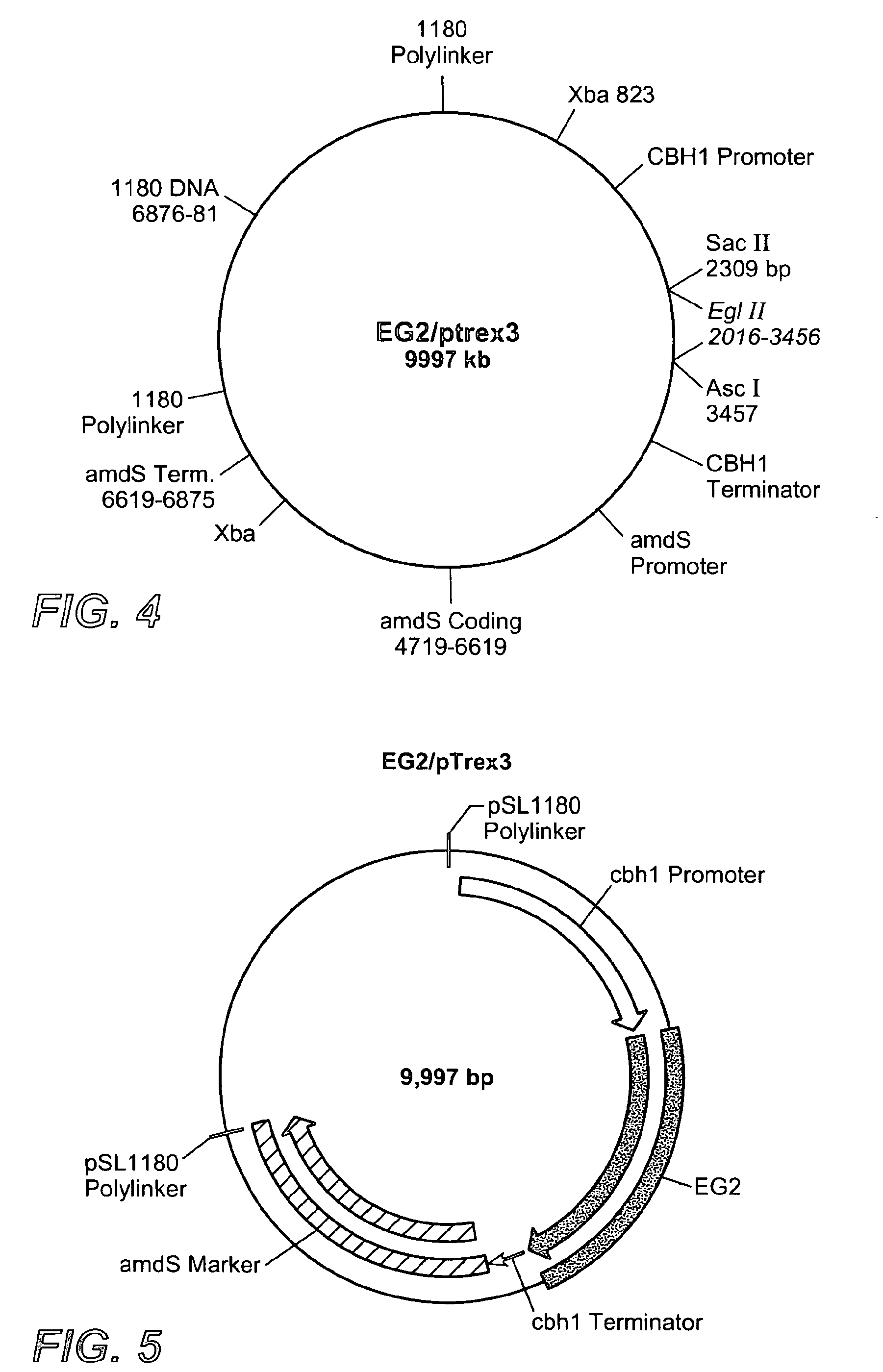Modified endoglucanase II and methods of use
a technology of endoglucanase and endoglucanase, which is applied in the field of modified endoglucanase ii, can solve the problems of unappealing fabric, unfavorable abrasion, and uneven fabric surface, and achieves enhanced abrasion, improved performance, and improved efficiency.
- Summary
- Abstract
- Description
- Claims
- Application Information
AI Technical Summary
Benefits of technology
Problems solved by technology
Method used
Image
Examples
example 1
EGII Expression
[0182]This example illustrates construction of host cells and expression of the modified EGII cellulase.
[0183]A strain that is low in cellulolytic activities was desired for biofinishing and denim washing applications. New strains were constructed with some or all of the major cellulases deleted. See U.S. Pat. No. 5,472,864 and WO 92 / 17574 for techniques to delete the desired cellulases, e.g., CBHI, CBHII, EGI, and EGII. The host strain used was T. reesei strain RL-P37. The derivation and characterization of this strain has been published previously (Sheir-Neiss and Montenecourt, 1984). It is a cellulase over-producing strain that has been obtained as a result of several mutagenesis steps from the wild-type strain (QM6a).
[0184]For T. reesei Eg2 A, sequences encoding CBHI, CBHII have been inactivated by deletion or disruption using molecular genetic techniques.
[0185]For T. reesei EG2 B, sequencing encoding CBHI, CBHII, EGI, and EGII have been inactivated by deletion or...
example 2
Biochemical Characterization of EG2 Enriched T. reesei Products
[0195]The following example details how the EGII was recovered and characterized.
[0196]T. reesei strain EG2 B produced a modified EG2 was grown in fermentors, using methods known in the art, the supernatent was recovered and concentrated using methods known to those skilled in the art. The supernatent product, modified EG2 (EG2 B), and IndiAge® Max L (EG2 A) were concentrated so that they would have the same amount of EG2 protein. IndiAge® Max L and modified EG2 were formulated with either 13% sorbitol, 1.35% sodium benzoate, or 13% glycerol, 1.35% sodium benzoate.
[0197]IndiAge® Max L was formulated to 124 g / L protein (scatter-corrected A 280 nm).
[0198]Densitometry (Amersham Biosciences) results from an SDS-PAGE gel indicated that the major component of this supernatent was about 35% EG1 and 50% EG2 protein. Modified EG2 was formulated to 78 g / L protein (Scatter-corrected A 280 nm). Densitometry (Amersham Biosciences) re...
example 3
Biopolishing Performance
[0204]This example describes differences in surface fiber removal and depilling that are found when cellulase products with a different composition are being used in finishing fabrics that contain cellulosic fibers. Specifically, this example describes that a modified EG II endoglucanase has an improved surface fiber removal compared to the EG II endo-enriched cellulase (IndiAge® MAX L, available from Genencor, Palo Alto, Calif.).
[0205]These cellulase compositions were tested for their ability to remove surface fibers and pills from fabrics containing cellulosic fibers.
[0206]Specifically, fabric samples (Brushed cotton knit; a 100% cotton interlock manufactured by Intertex LLC (Garden Grove, Calif.) that is dyed with reactive royal blue and one side of the fabric is brushed) were treated in a Thies mini-soft (3 kg) jet dyer (Thies, Coesfeld Germany; on the Web at thiestextilmaschinen.de) under the following conditions:[0207]Buffer pH 5: sodium citrate di-hydr...
PUM
| Property | Measurement | Unit |
|---|---|---|
| temperature | aaaaa | aaaaa |
| pH | aaaaa | aaaaa |
| temperature | aaaaa | aaaaa |
Abstract
Description
Claims
Application Information
 Login to View More
Login to View More - R&D
- Intellectual Property
- Life Sciences
- Materials
- Tech Scout
- Unparalleled Data Quality
- Higher Quality Content
- 60% Fewer Hallucinations
Browse by: Latest US Patents, China's latest patents, Technical Efficacy Thesaurus, Application Domain, Technology Topic, Popular Technical Reports.
© 2025 PatSnap. All rights reserved.Legal|Privacy policy|Modern Slavery Act Transparency Statement|Sitemap|About US| Contact US: help@patsnap.com



